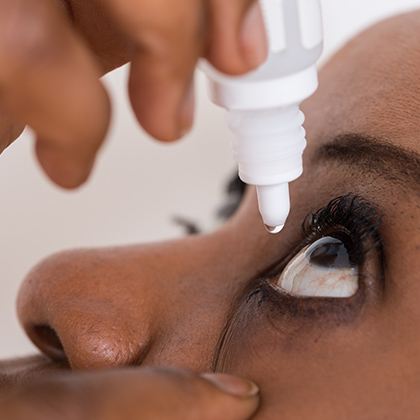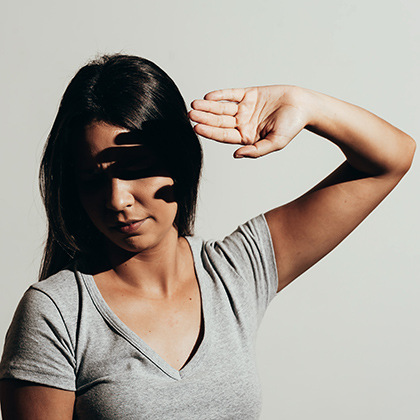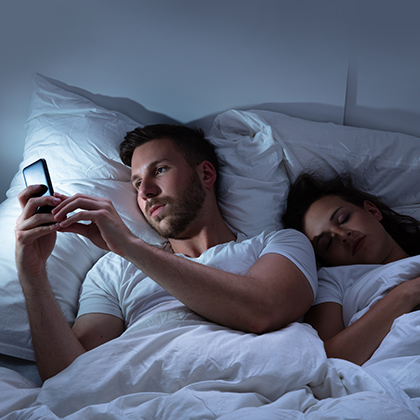
If your eyes hurt when they are exposed to daylight, they feel uncomfortable when you walk into a brightly lit room or you even experience pain in your eyes from light during a migraine, there’s a good chance that you’re affected by photophobia. This is abnormal visual intolerance to light, also known as light sensitivity.
The word photophobia is derived from two Greek words: photo, meaning light, and phobia, meaning a fear or dread of. But this is misleading since photophobia doesn’t mean you’re afraid of light. It is the term for the experience of visual pain and discomfort caused by light exposure.
If you think you may be affected by light sensitivity, this guide will help you understand more about it and the conditions that are thought to trigger it.
The importance of light for vision
Light is essential for our vision as it helps us to see the things around us as well as colour. It bounces off the things we look at, with different objects reflecting different levels of light. Then it enters our eyes, passing through the cornea (the transparent front part of the eye) and the lens, then collected by the retina. While light is essential for vision, it can also cause problems for people with photophobia.
Which conditions are linked to photophobia?
Some people with certain eye conditions find they’re also sensitive to light, including those with the following:
-
Blepharospasm (involuntary blinking and closing of the eyelids)
-
Uveitis and iritis (inflammation affecting the middle layer of the eye)
-
Ocular albinism (lack of pigment in the eye)
-
Detached retina
-
Corneal abrasion or corneal ulcers
Other non-vision-related conditions that have been found to cause photophobia to include migraine, with researchers suggesting up to 80 per cent of people who have migraines also experience photophobia during an attacki. But a migraine isn’t the only headache type associated with photophobia. Those who experience ‘tension’ headaches may be more sensitive to light than usual. Those affected by cluster headaches can experience photophobia tooiii.
 Several other conditions are related to photophobia, including trigeminal neuralgia (severe facial pain), meningitis, brain haemorrhage and brain injuryiv, v, vi Some mental health problems have been linked with light sensitivity. For instance, people with agoraphobia, a fear of being in situations where escape might be difficult, report feeling more relaxed in low-light conditions, as they find bright light triggers anxietyi. Other mental health conditions associated with photophobia include depression and bipolar disorder.
Several other conditions are related to photophobia, including trigeminal neuralgia (severe facial pain), meningitis, brain haemorrhage and brain injuryiv, v, vi Some mental health problems have been linked with light sensitivity. For instance, people with agoraphobia, a fear of being in situations where escape might be difficult, report feeling more relaxed in low-light conditions, as they find bright light triggers anxietyi. Other mental health conditions associated with photophobia include depression and bipolar disorder.
Certain medicines can cause photophobia too, including the antibiotics tetracycline and doxycycline, the heart medication digitalis and a drug used to treat malaria called quininevii.
What exactly causes photophobia?
Photophobia is thought to be fairly common. However, the mechanisms that trigger it are still not really understood. A popular view is that it has something to do with the trigeminal nerve, one of 12 cranial nerves that supply sensations (including pain) to the face, mucous membranes and other parts of the headvi.
These nerve fibres are found in dense concentrations in parts of the eye called the conjunctiva, cornea, sclera and uvea, and are very sensitive to pain. This, according to researchers writing in the Journal of Neuro-ophthalmology, may explain why conditions such as corneal abrasions, dry eye syndrome and uveitis, which affect some of these areas within the eye – often also cause photophobiai.
Elsewhere, researchers suggest that light sensing (melanopsin) cells in the retina project to areas where light and pain meet, which they say offers an explanation for why some people who are blind can still experience photosensitivityii.
It’s also possible to experience photophobia without having any related underlying medical cause whatsoever. Age may play a part too since some photophobia-related eye conditions are more common in older people (cataracts, macular degeneration and dry eye syndrome, for instance). Or it may simply be that most of us become more sensitive to light as we get older, thanks to the changes that take place in our eyes over time.
What can you do?
If you start to experience light sensitivity, it’s important to get your eyes tested by an optician to check for any underlying eye conditions, as treating such conditions can help reduce light sensitivity or even get rid of it altogether. For instance, as dry eye is considered a common cause of photophobia, keeping your eyes sufficiently lubricated may bring relief from light sensitivity too. Read our article Dehydration and Eye Health: How to Prevent Dry Eyes.
But even without any known cause, photophobia can be painful and frustrating. Either way, wearing suitable sunglasses or tinted lenses can be very helpful. Your optician can advise you about different tints or levels of tints you could use indoors and which you might find effective outdoors, including when you’re driving.
There’s also lots more information on keeping your eyesight healthy in the rest of our Vision Health Hub articles – why not take a look?
References:
-
Digre, K.B., Brennan, K.C. Shedding Light on Photophobia. J Neuroophthalmol. (2012 Mar) ;32(1): 68–81. Available online: https://www.ncbi.nlm.nih.gov/pmc/articles/PMC3485070
-
Noseda,, et al. A neural mechanism for exacerbation of headache by light. Nat Neurosci. (2010 Feb) ;13(2): 239–245. Available online: https://www.ncbi.nlm.nih.gov/pmc/articles/PMC2818758
-
Rossi, H.L., Recober, A. Photophobia in Primary Headaches. Headache. (2015 Apr) ;55(4): 600–604. Available online: https://www.ncbi.nlm.nih.gov/pmc/articles/PMC4459705
-
Available online: https://journals.lww.com/jneuro-ophthalmology/Citation/1994/06000/Photophobia_in_Trigeminal_Neuralgia.17.aspx
-
Katz, B.J., Digre, K.B. Diagnosis, pathophysiology and treatment of photophobia. Surv of Opthal. Vol 61, 4, 466-477. Available online: https://www.surveyophthalmol.com/article/S0039-6257(15)30007-2/fulltext
-
Digre, K.B., Brennan, K.C. Shedding Light on Photophobia. J Neuroophthalmol. (2012 Mar) ;32(1): 68–81. Available online: https://www.ncbi.nlm.nih.gov/pubmed/22330853
-
Eyecare Trust. Date accessed 12/12/2018. Available online: https://www.eyecaretrust.org.uk/view.php?item_id=97
Related Posts?
Disclaimer: The information presented by Nature's Best is for informational purposes only. It is based on scientific studies (human, animal, or in vitro), clinical experience, or traditional usage as cited in each article. The results reported may not necessarily occur in all individuals. Self-treatment is not recommended for life-threatening conditions that require medical treatment under a doctor's care. For many of the conditions discussed, treatment with prescription or over the counter medication is also available. Consult your doctor, practitioner, and/or pharmacist for any health problem and before using any supplements or before making any changes in prescribed medications.

Christine
Christine Morgan has been a freelance health and wellbeing journalist for almost 20 years, having written for numerous publications including the Daily Mirror, S Magazine, Top Sante, Healthy, Woman & Home, Zest, Allergy, Healthy Times and Pregnancy & Birth; she has also edited several titles such as Women’ Health, Shine’s Real Health & Beauty and All About Health.
View More



